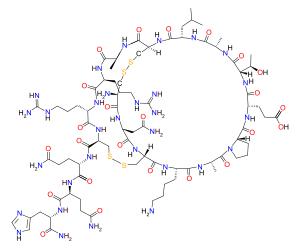
| |
| Identifiers | |
|---|---|
3D model (JSmol)
|
|
| ChEMBL | |
| ChemSpider | |
| ECHA InfoCard | 100.041.969 |
PubChem CID
|
|
| UNII | |
CompTox Dashboard (EPA)
|
|
| |
| |
| Properties | |
| C79H131N31O24S4 | |
| Molar mass | 2027.33874 g/mol |
Except where otherwise noted, data are given for materials in their standard state (at 25 °C [77 °F], 100 kPa).
| |
| Apamin Preproprotein | |||||||
|---|---|---|---|---|---|---|---|
| Identifiers | |||||||
| Symbol | Apamin | ||||||
| CAS number | |||||||
| NCBI gene | 406135 | ||||||
| UniProt | P01500 | ||||||
| |||||||
Apamin is an 18 amino acid globular peptide neurotoxin found in apitoxin (bee venom).[2] Dry bee venom consists of 2–3% of apamin.[3] Apamin selectively blocks SK channels, a type of Ca2+-activated K+ channel expressed in the central nervous system. Toxicity is caused by only a few amino acids, in particular cysteine1, lysine4, arginine13, arginine14 and histidine18. These amino acids are involved in the binding of apamin to the Ca2+-activated K+ channel. Due to its specificity for SK channels, apamin is used as a drug in biomedical research to study the electrical properties of SK channels and their role in the afterhyperpolarizations occurring immediately following an action potential.[4]
- ^ Apamin - Compound Summary, PubChem.
- ^ Habermann E (1984). "Apamin". Pharmacology & Therapeutics. 25 (2): 255–70. doi:10.1016/0163-7258(84)90046-9. PMID 6095335.
- ^ Son DJ, Lee JW, Lee YH, Song HS, Lee CK, Hong JT (Aug 2007). "Therapeutic application of anti-arthritis, pain-releasing, and anti-cancer effects of bee venom and its constituent compounds". Pharmacology & Therapeutics. 115 (2): 246–70. doi:10.1016/j.pharmthera.2007.04.004. PMID 17555825.
- ^ Castle NA, Haylett DG, Jenkinson DH (Feb 1989). "Toxins in the characterization of potassium channels". Trends in Neurosciences. 12 (2): 59–65. doi:10.1016/0166-2236(89)90137-9. PMID 2469212. S2CID 22356085.